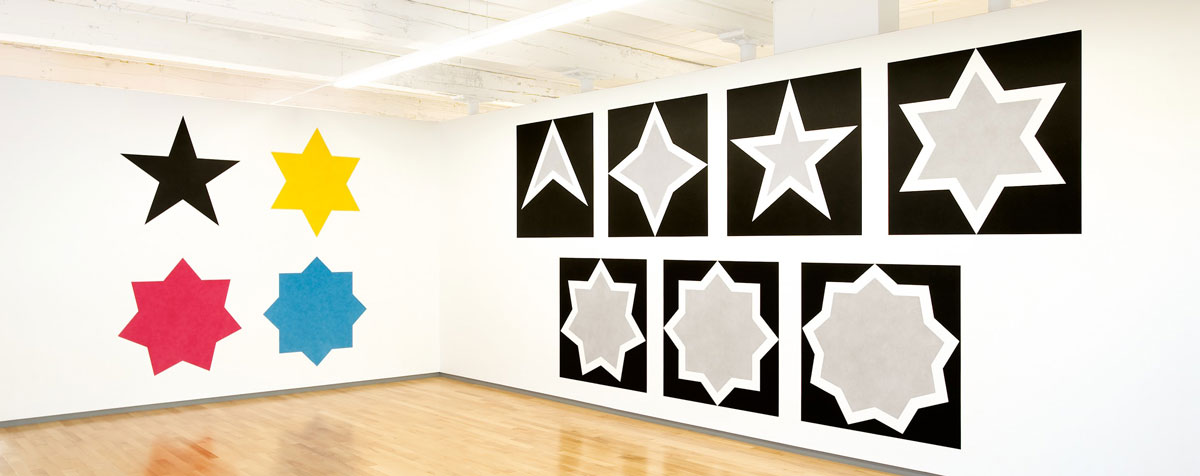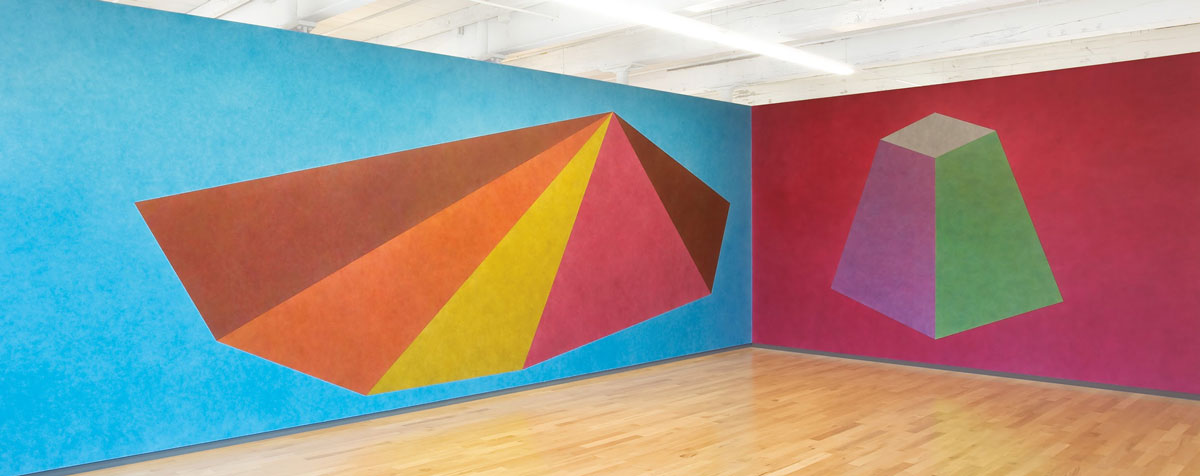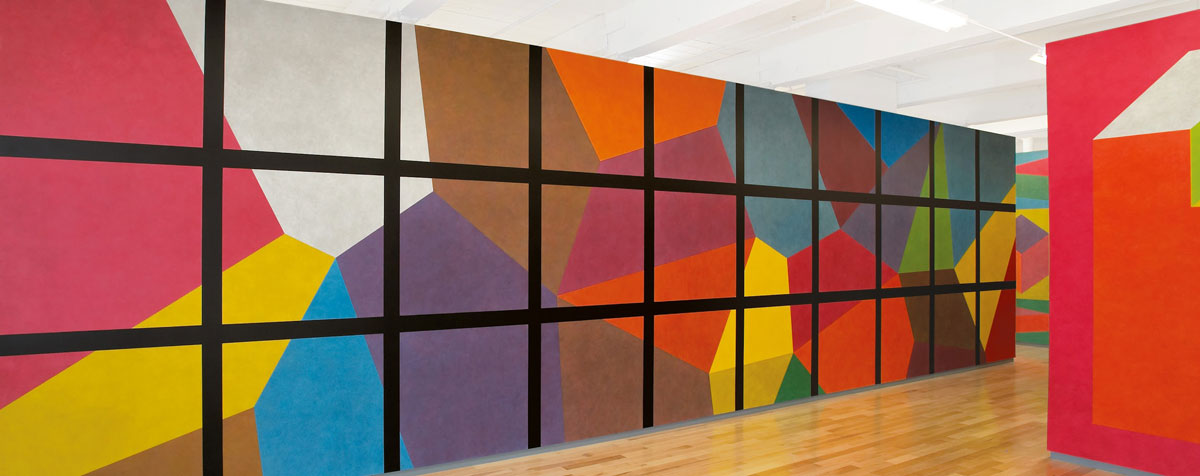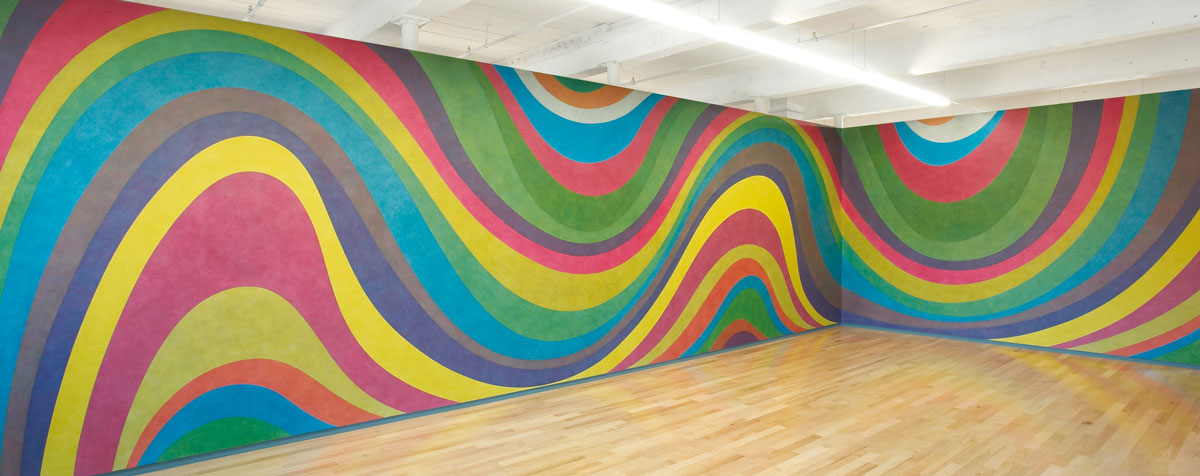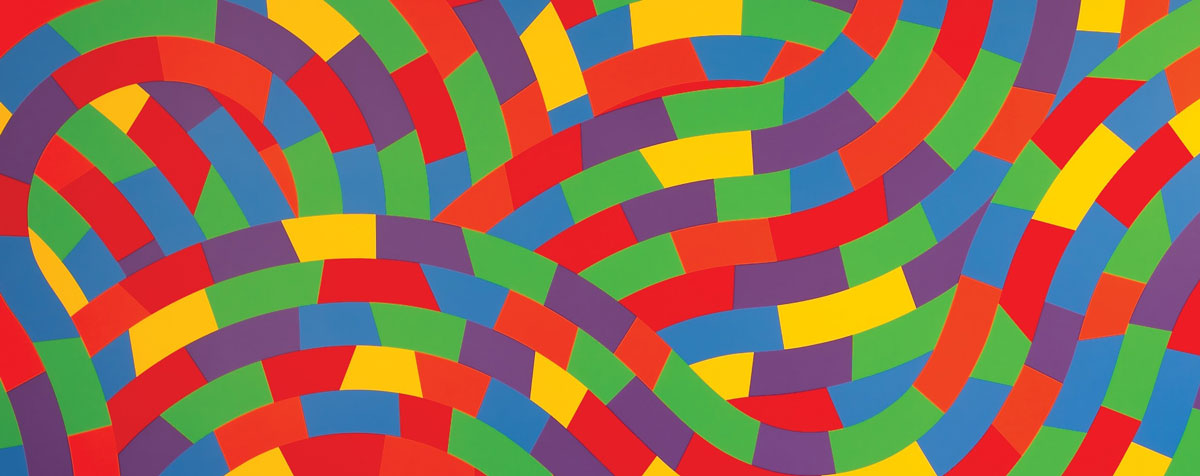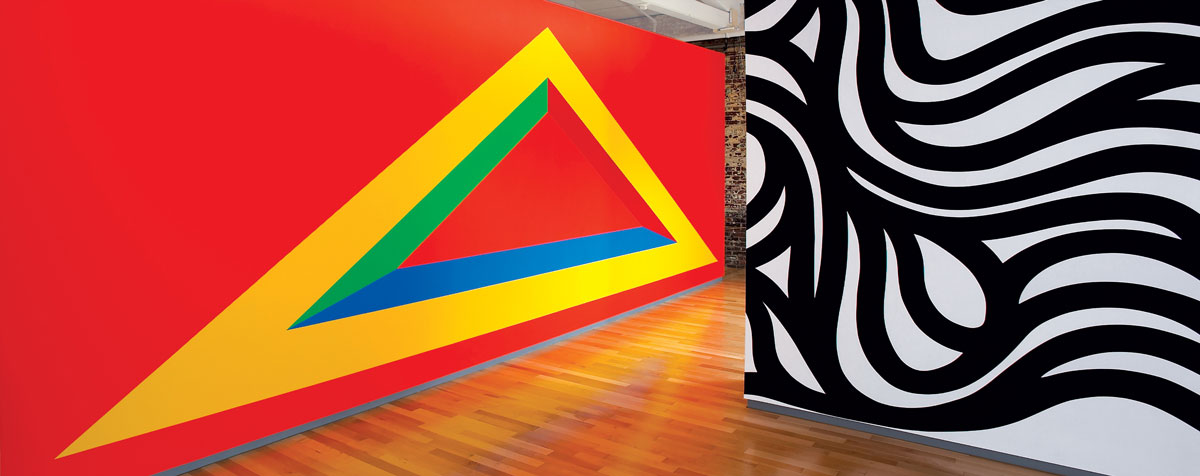ART-TRIBUTE:Sol LeWitt-A Wall Drawing Retrospective,Part II
 Sol LeWitt (who stressed the idea behind his work over its execution) is widely regarded as one of the leading exponents of Minimalism and Conceptual Art, and is known primarily for his deceptively simple geometric structures and architecturally scaled wall drawings. His experiments with the latter commenced in 1968 and were considered radical, in part because this new form of drawing was purposely temporal and often executed not just by LeWitt but also by other artists and students whom he invited to assist him in the installation of his works (Part I & Part III).
Sol LeWitt (who stressed the idea behind his work over its execution) is widely regarded as one of the leading exponents of Minimalism and Conceptual Art, and is known primarily for his deceptively simple geometric structures and architecturally scaled wall drawings. His experiments with the latter commenced in 1968 and were considered radical, in part because this new form of drawing was purposely temporal and often executed not just by LeWitt but also by other artists and students whom he invited to assist him in the installation of his works (Part I & Part III).
By Efi Michalarou
Photo: MASS MoCA Archive
“Sol LeWitt: A Wall Drawing Retrospective” comprises 105 of LeWitt’s large-scale wall drawings, spanning the artist’s career from 1969 to 2007. These occupy nearly an acre of specially built interior walls that have been installed, per LeWitt’s own specifications, over three stories of a historic mill building situated at the heart of MASS MoCA’s campus. The exhibition is a collaboration of MASS MoCA, Yale University Art Gallery, the Williams College Museum of Art, and the Sol Lewitt Estate, over 60 artists and art students spent six months rendering 105 large-scale wall drawings spanning the artist’s storied career. Each wall drawing begins as a set of instructions or a simple diagram to be followed in executing the work. As the exhibition makes clear, these straightforward instructions yield an astonishing variety of work that is at once simple and highly complex, rigorous, and sensual. The drawings in the exhibition range from layers of straight lines drawn in black graphite pencil lead, to rows of delicately rendered wavy lines in colored pencil; from bold black-and-white geometric forms, to bright planes in acrylic paint arranged like the panels of a folding screen; from sensuous drawings created by dozens of layers of transparent washes, to a tangle of vibratory orange lines on a green wall, and much more. Forms may appear to be flat, to recede in space, or to project into the viewer’s space, while others meld to the structure of the wall itself, like gauze. Sol LeWitt executed his first wall drawing in 1968 at Paula Cooper Gallery in New York. LeWitt’s drawings (both on paper and on the wall grew out of the artist’s serial, three-dimensional work which systematically investigated variations on modular cube structures. LeWitt would use the same system of permutations and variations in his drawings. Early in his career, Sol LeWitt began to have others help execute his wall drawings. “Wall Drawing 16”, for example, was first drawn by James Walker. By allowing other draftsmen to realize his work according to his instructions and diagrams, LeWitt addressed practical concerns such as the time-consuming nature of the drawings. More significantly, however, this choice articulated LeWitt’s belief that the conception of the idea, rather than its execution, constitutes the art work. He was also rejecting the traditional importance assigned to the artist’s own hand. “Wall Drawing 46” is dedicated to sculptor Eva Hesse. Sol LeWitt and Hesse were close friends, and LeWitt credits Hesse’s aesthetic sensibilities with motivating his use of the not straight line. This type of mark appears here for the first time, in the drawing originally executed two days after Hesse’s death. Subsequent drawings saw the use of not straight lines in four colors and in various combinations with straight lines, broken lines and arcs. The drawing is often done by a single draftsman in order to achieve a consistency in line density and thickness. The process of drafting “Wall Drawing 46” begins with stretching vertical plumb lines in string over the wall to help the draftsman maintain the essential verticality of the lines. Then, the draftsman begins by making longer marks all over the wall, filling in the available spaces with shorter lines until the wall is evenly covered. Sol LeWitt created Wall “Drawing 340” during a period of experimentation with basic geometric shapes. His formal vocabulary included what the artist referred to as primary shapes: circle, square, triangle, and secondary shapes: parallelogram, trapezoid, and rectangle. While earlier drawings, such as Wall “Drawing 295” (also on display at MASS MoCA) depict these shapes in outline only, in Wall Drawing 340 the shapes are delineated by straight, parallel, horizontal, and vertical lines (the most basic elements of LeWitt’s vocabulary). Later, the geometric forms became even bolder as LeWitt began entirely filling them in with solid colors. Geometric shapes began to appear in outline in Sol LeWitt’s wall drawings as early as 1975, but it was not until the 1980s that the artist began to draw solid geometric shapes, such as the stars in “Wall Drawing 396”. The stars are executed in ink, a medium that LeWitt had recently adopted. Shapes executed in ink were much bolder and more saturated than those drawn in crayon, the medium that LeWitt had previously used. This drawing, an example of LeWitt’s early experimentation with the star shape, consists of a series of stars, each with one more point than the last. The artist defines stars by the geometry of the circle; each point of a star touches the circumference of a circle. Within the circle the draftsmen construct the star using geometric formulae. The heptagon, or seven-sided, shape in “Wall Drawing 396” is problematic for the draftsmen in that it is composed of all irrational angles. These angles are difficult to construct with a ruler and compass, which LeWitt’s draftsmen usually use, because of the approximation that they necessitate. “Wall Drawing 462” is one of a series featuring ink wash arcs and circles in varying colors and orientations. This series represents one of the many in which Sol LeWitt applied a new medium to the themes first used in his pencil wall drawings. In the early 1970s the artist created a series of wall drawings presenting arcs, circles, and sometimes grids. As in these pencil drawings, the draftsmen drew the arcs in “Wall Drawing 462” using a giant compass. The centers of the arcs, or the points from which the compass is rotated, are defined as the center of the wall and the midpoints of the sides of the walls, points that LeWitt repeatedly uses as part of his lexicon, along with the four corners of walls. By using these basic points on the wall as reference spots, the artist removed particular subjective decision-making from the structure and composition of many of his works. In the original January 1986 installation of “Wall Drawing 462” at Galleria Studio G7 in Bologna, Italy, the drawing was executed on four walls of a room with a vaulted ceiling. Unlike the three square-topped walls on which the drawing was executed at MASS MoCA, the scallop-topped walls highlighted the pattern of the arcs, creating the sense that the viewer is completely enveloped by the hypnotic gray and black bands. “Wall Drawing 610” was first drafted in the late 1980s, during the period of Sol LeWitt’s career in which he was creating ink wash wall drawings featuring isometric forms. This staircase-like isometric figure implies volume, canted as it is towards the viewer, yet does not imply linear recession. The base and left-hand edge of the figure are parallel with the edges of the wall, acknowledging flatness, and the steps are angled, revealing additional faces to the prism without implying depth. This uneven and non-illusionistic method of implying three-dimensionality has several precedents in art history, such as the intuitive perspective used by Egyptian relief sculptors, and the tilted perspective that appears in early Renaissance panel painting and frescoes. This wall drawing is also an interesting example of LeWitt’s technique of superimposing ink washes in order to create colors and tones. The background is in his primary red, and the foremost panel on the figure is orange: equal parts red and yellow ink. In “Wall Drawing 692”, as in most of LeWitt’s ink wall drawings from this period, LeWitt instructs draftsmen to layer different combinations of the four ink colors (gray, yellow, blue, red), creating a variety of hues. The artist’s instructions exist in the form of combinations of letters (G,Y,B,R). In some of the ink works, these combinations are not systematic, but random—they depend on the artist’s intuition. In the first few years of the 21st Century Sol LeWitt created many acrylic wall drawings which feature geometric configurations composed of brilliantly colored bars. Several of these works were first displayed in a 2001 exhibit at Fundación PROA in Buenos Aires. Shown together, the primary and secondary colored bars seem to jut out from the contrasting backgrounds, creating a sense of space and atmosphere. The three-dimensionality of the bars in “Wall Drawing 1005” and its contemporaries represents a continuation of the ideas that the artist explored in his ink isometric form wall drawings created between the 1980s and the early 1990s. Shapes drawn using isometric projection possess volume, but exist in space that does not recede. Unlike the muted jewel-toned ink wash palette, the bright acrylic hues of the later works make the forms appear to pop out from their backgrounds, creating a visual tension between the flatness of the wall and the three-dimensionality of the form. First executed in August 2005, “Wall Drawing 1171” is part of a series of scribbled wall drawings that LeWitt began that year. In this series, LeWitt returns to graphite, the medium of his early wall drawings, and abandons color, which had been a primary aspect of his work since the 1980s. The loose, irregular scribbles in five degrees of density are encaged in the rigid, geometric cubes, striking a balance between chaos and control. The illusionism here is complicated — the isometric perspective does not use vanishing points, so there is no recession of space. Thus, LeWitt is able to show volume without contradicting the flatness of the wall.
Info: MASS MoCA, 1040 MASS MoCA WAY, North Adams, Duration 16/11/2008-2/10/2043, Days & Hours: Wed-Mon 11:00-17:00 (Fall/Winter/Spring) or Sun-wed 10:00-18 & Thu-Sat 10:00-19:00 (Summer), https://massmoca.org
